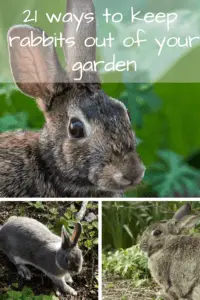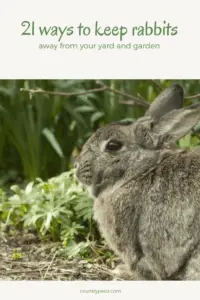How to Get Rid of Wild Rabbits From Your Yard
A few weeks ago, my 10 yr old daughter found a family of rabbits living in our field. Since its only a matter of time before they find their way into my garden and yard, I need to keep them out. I've done a little research and found several ways to keep rabbits out of a garden and yard.
21 Effective Ways to Keep Rabbits Out of Your Yard and Garden
- Clean up the hiding places: bushes, woodpiles and hanging branches
- Eliminate food sources
- Add barriers to protect your plants
- Use a dog to scare the rabbit away
- Employ scare devices to frighten rabbits
- Use Rabbit repellants
- Trap and relocate
- Add barriers
- Engage smelly plants
- Avoid Tactics That Don't Work
Of course, there is no single foolproof way to keep rabbits out. That's why it's important to have several methods to keep these pests out. Depending on whether you live in the city or the country, different methods will have varying results. Let's discuss which ways are the most effective.

Clean Up Hiding Places: Bushes, Woodpiles, And Hanging Branches
Rabbits have a lot of predators so they naturally like to keep safe. Bushes, low hanging branches, and other shelters make ideal hiding places for rabbits. If you eliminate the safety attraction, it will help to keep the rabbits from hiding on your property. Rabbits don't like wide open places as much as places that allow hiding or burrowing. We once spent nearly 2 hours trying to chase a rabbit out of our garage, which produces an endless supply of hiding places for the darn pest.
You can keep rabbits out from under your deck by fencing the latticework with chicken wire. Check for other holes and hiding places for rabbits to hide around sheds and other structures.
- Trim low hanging branches and bushes
- Seal off hiding places by fencing the deck off with chicken wire
- Eliminate other hiding places around your property by sealing them off or eliminating them.
- Seal spaces beneath buildings
Eliminate Food Sources
Rabbits eat, a lot, so they are constantly on the prowl for more food. As a result, your yard may be attracting rabbits into it by smell. Keep fruit and garbage contained in containers with lids. Rabbits will be attracted to tree bark, vegetables, potted plants and other types of food. It's not usually practical to completely eliminate food sources, but you can make them difficult to reach.
Protect Plants From Rabbits
You can protect your garden, flowers, and trees with a little planning. Garden plants can be protected with netting or chicken wire. This prevents the rabbits from munching down on your harvest. Trees can be also be protected with chicken wire or tree guards. Since rabbits like to eat bark, they can quickly kill a young tree and do irreparable damage. Potted plants can be better protected using mulch around the plant. It doesn't completely protect the plant from getting munched, but can prevent rabbits from digging down around the plant. Rocks, woodchips, and other mulch are usually effective for this purpose.
In the garden, you can also keep it weeded and clean. This means that rabbits will have to forage for their food in open spaces and adds a little more of a deterrent, especially if that food is protected with mesh. You can also try brushing plants with talcum powder to discourage rabbit munching.
- Low fencing, mesh, or chicken wire helps to protect plants.
- Fencing around the trunks of trees prevents rabbits from chewing the bark
- Mulch discourages digging around plants
- Keep the garden clean so weeds don't provide additional cover or protection
- Brush Plants with talcum powder.

Keep Rabbits Away By Unleashing Buddy
Rabbits are naturally fearful of dogs. Unless your dog and the rabbits have been raised to coexist, your best friend may keep the rabbits away. Dogs are loud, easily kill rabbits, and often just as fast. This means that rabbits usually make a hasty retreat when a dog is around. Plus, dog's keen sense of smell means that he'll usually notice rabbit visitors before you are likely to spot them.
Employ Scare Tactics to Frighten Away Rabbits
Rabbits will generally not stay away from scare devices. They adjust very quickly. However, you can use a combination of shiny objects such as mirrors, old CDs and tins to scare them away. Things that blow in the wind will be less predictable and slightly more effective.
Use Rabbit Repellants
Common rabbit repellants include human and dog hair. It also includes strong smelling repellants such as pungent essential oils, or peppers. Cat litter, raw or suffered eggs, and garlic are also useful to repel rabbits. Blood is a detergent for rabbits. You can purchase blood meal or bonemeal and sprinkle it around your plants. (This could attract other predators).
Sprinkle the smelly substance around plants. Soak rags in ammonia and place them around your yard and garden. If you purchase rabbit repellants, look for those with naphthalene or potassium salts as they tend to be more effective in protecting your plants from rabbits.
Another popular repellant is the use of Irish soap. Hang little bags of shavings around the garden. The strong scent helps to repel rabbits.
Coyote urine is also popular. Since coyotes kill house cats, they usually stay away from the scent of such a bit animal.
Depending on the type of repellant you use, you will want to be aware that other animals may also be repelled. Be careful using ammonia in places where your pets frequent as it can negatively affect them.
If you choose to use repellants, they will need to be reapplied frequently or after any rain or snow. You will need to carefully adhere to the instructions for any purchased repellant you use.
- Human and animal hair
- Cat litter
- Sulfered or raw eggs
- Garlic, pepper and other smelly plants
- Ammonia
- Irish Soap
- Bloodmeal opr bone meal
- Coyote Urine
Check out rabbit repellants on our recommended products page.
Trap and Relocate
Trapping is not always a feasible option. You will want to make sure that you understand what your local ordinances allow. Relocating rabbits within city limits is often prohibited. Additionally, rabbits can carry diseases such as hantavirus, salmonella, and others. You should understand the risks and how to protect yourself from this risk. If you don't understand how to safely trap a rabbit, consider hiring a professional.
In many states, rabbits are considered agricultural pests. This means that relocating rabbits is often regulated by local or state laws. Make sure you understand your local regulations before attempting to relocate rabbits away from your property.
- Trapping rabbits create danger to the trapper who may not understand how to keep themselves free of injury or disease
- Relocation is often regulated locally because rabbits are considered pests and often carry many diseases
Add Barriers to Rabbit Entry
If you decide to add fencing to keep rabbits out of your yard and garden, make sure it is at least 2-3 feet high. Any shorter and rabbits will be able to jump over it. Additionally, rabbits are wonderful diggers. You should bury the fence at least six inches below the ground. 8-10 inches will be even more effective. This will help to prevent them from digging below the fence.
Chicken wire can be great and cheap fencing to use to wall off rabbits. The wire should have a ½ inch to 1-inch mech. Another option is to use electric net fencing for seasonal gardens.
- Fences should be at least 2 feet high
- Gaps should not be any larger than ½ to 1 inch wide. Even a small gap in a wood fence will let in a rabbit
- Fences should be partially buried. 6 inches is a minimum burial depth to keep rabbits from digging under fences.
Engage Smelly Plants
Rabbits have a great sense of smell. Use that gift against them by employing plants and smells that deter rabbits. This isn't a fool-proof method as desperate rabbits will ignore the smell or eventually get used to it. However, it can be used to strengthen other deterrents.
Consider planting onions and garlic among your carrots, cabbages, and lettuce to deter rabbits. The strong odor often keeps them at bay. Plants rabbits tend to dislike include:
- Garlic and onions
- Rhubarb
- Oregano, mint, parsley, and basil
- Geraniums
- Daffodils and hyacinths
Rabbit Defenses That Don't Work
- Scarecrows, fake owls, and rubber snakes: These tools are rarely effective in keeping rabbits away. Rabbits may hesitate briefly before venturing out, but quickly get used to them.
- Noise and Lights: Rabbits are rarely scared away by light and noise devices. It takes them only a matter of a few hours to adjust to the deterrent.
- Pesticides: The EPA has not approved any pesticides for use on rabbits. You should not use rodent poison or other toxins to kill rabbits. It is difficult to control and can have unintended consequences. You are more likely to kill your pets or harm small children.
Related Questions
How can I recognize rabbit signs in my yard? Rabbits are often easy to spy during daylight hours. Rabbits don't feel as threatened during the day. If you suspect rabbits but haven't spied one, then check out your plants.
Rabbits tend to munch plants near ground level. Rabbits have sharp front teeth. As a result leaves and stalks will tend to be cut. It will look like they were cut with scissors.
Rabbits much on twigs, young trees, or bushes. The cut marks will be low to the ground and will appear to be cut. You may see cuts at 45-degree angles.
Rabbits love young tender shoots. If you notice your young plants vanishing overnight without a trace, it is often a rabbit.
You may also see small droppings. Rabbits have small pea-sized scat (poop). Their droppings are dry. You may also see small holes around your garden and yard.
- Sharp cuts like scissors
- Small pellet poop the size of a pea
- Foraging at ground level such as at the base of a tree
- Plants disappearing overnight with no trace
Is it true that rabbits hate reflections? An old legend states that rabbits are afraid of their own reflection. Some homeowners keep rabbits away from their yard and gardens by employing the use of mirrors around the restricted areas.
How do I tell if the rabbits are Ferrell or wild? Laws regarding rabbits often differ depending on whether the rabbits are offspring of captive rabbits that have been released or wild rabbits. Most rabbits have a brown coat. Colder, northern areas may have wild rabbits who develop a white coat to blend in with the now in the winter. If the rabbits are black, white, or spotted int he summer, then you are likely dealing with Ferrell rabbits instead of wild ones. Jackrabbits have longer ears and are generally larger in size.
Conclusion
One rabbit usually signals many, many more. Rabbits are prolific at reproduction and usually live in groups. Even a single rabbit can consume a large quantity of plants and tree bark. In addition, rabbits tend to attract larger predators as an easy meal. As a result, it's important to be diligent about keeping rabbits out of your yard or garden.
[post-carousel id="364″]


How to Get Rid of Wild Rabbits From Your Yard
Source: https://countrypests.com/21-effective-ways-to-keep-rabbits-out-of-your-yard-and-garden/
0 Response to "How to Get Rid of Wild Rabbits From Your Yard"
Post a Comment